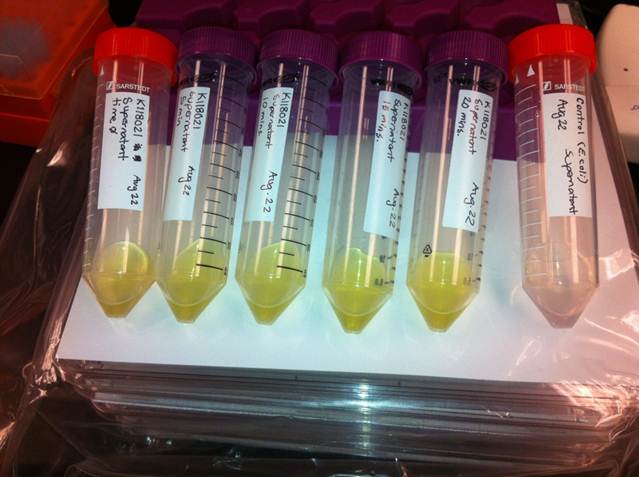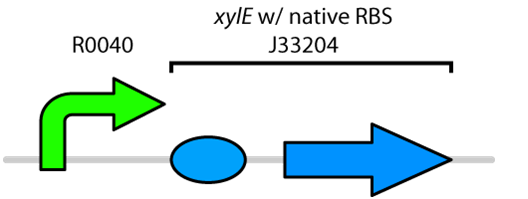Team:Calgary/Project/OSCAR/CatecholDegradation
From 2012.igem.org
| Line 11: | Line 11: | ||
<p> | <p> | ||
| - | + | Currently the regitry has two BioBricks available of <i>xylE</i>. One contained <i>xylE</i> with its native ribosome-binding site (part: <a href=http://partsregistry.org/Part:BBa_J33204>J33204</a>), while the other part contained <i>xylE</i> under the glucose-repressible promoter <i>cstA </i>(<a href=http://partsregistry.org/Part:BBa_K118021>BBa_K118021</a>). Given that <i>E. coli</i> is grown in the presence of glucose, we designed a new construct to keep <i>xylE</i> repressed by using the TetR promoter (<a href= http://partsregistry.org/Part:BBa_R0040>BBa_R0040</a>).</p> | |
</html>[[File:UCalgary2010_R0040-XylE.png|400px|thumb|Fig.1 Genetic circuit for catechol degradation showing <i>XylE</i> biobricked under the TetR promoter|center]]<html> | </html>[[File:UCalgary2010_R0040-XylE.png|400px|thumb|Fig.1 Genetic circuit for catechol degradation showing <i>XylE</i> biobricked under the TetR promoter|center]]<html> | ||
| Line 20: | Line 20: | ||
</html>[[File:UCalgary2012_Catechol_to_2-HMS.PNG|400px|thumb|Fig.2 Catechol 2,3-dioxygenase (<i>XlyE</i>) converts catechol to 2-Hydroxymuconate semialdehyde in the presence of oxygen. Adapted from Shu <i>et al</i>., 1995.|center]]<html> | </html>[[File:UCalgary2012_Catechol_to_2-HMS.PNG|400px|thumb|Fig.2 Catechol 2,3-dioxygenase (<i>XlyE</i>) converts catechol to 2-Hydroxymuconate semialdehyde in the presence of oxygen. Adapted from Shu <i>et al</i>., 1995.|center]]<html> | ||
| - | <p>The visual assays were performed with <i>E.coli</i> cells transformed with <a href=http://partsregistry.org/Part:BBa_K118021> | + | <p>The visual assays were performed with <i>E.coli</i> cells transformed with <a href=http://partsregistry.org/Part:BBa_K118021>BBa_K118021</a> as well as with <i>E.coli</i> cells transformed with the newly constructed part (<a href=http://partsregistry.org/Part:BBa_K902048 >BBa_K902048</a>) by bringing the supernatant of an overnight culture to a concentration of 0.1 M of catechol. When the part <a href=http://partsregistry.org/Part:BBa_K118021>BBa_K118021</a> was used, the pellet was first washed in M9-MM and centrifuged before catechol was added to the supernatant. This was necessary to avoid the glucose in the LB from repressing the cstA promoter (<a href=http://partsregistry.org/Part:BBa_K118011>BBa_K118011</a>). Catechol was added to the supernatant because the reaction takes place outside of the cell. Within minutes of the addition of catechol to the supernatant, the solution turned from the pale yellow of LB to a bright yellow. This assay was completed by following the protocol written by the 2008 Edinburgh iGEM team.</p> |
</html>[[File:UCalgary2012_Catechol_assay.jpg|500px|thumb|Fig.3 Results of the catechol visual assay using the part K118021. Cultures were grown overnight in LB and the pellets were washed with M9-MM for varying times (From left to right: 0 min, 5 min, 10 min, 15 min, and 20 min.). After this incubation in M9-MM the cells were spun down and catechol was added to the supernatant to bring it to a concentration of 0.1 M. The amount of time didn't affect the colour change in the cultures containing the <i>XylE</i> gene. The right most tube was a culture of <i>E.coli</i> cells without the <i>XylE</i> gene that was used as a control. The controls supernatant remained clear when the catechol was added. |center]]<html> | </html>[[File:UCalgary2012_Catechol_assay.jpg|500px|thumb|Fig.3 Results of the catechol visual assay using the part K118021. Cultures were grown overnight in LB and the pellets were washed with M9-MM for varying times (From left to right: 0 min, 5 min, 10 min, 15 min, and 20 min.). After this incubation in M9-MM the cells were spun down and catechol was added to the supernatant to bring it to a concentration of 0.1 M. The amount of time didn't affect the colour change in the cultures containing the <i>XylE</i> gene. The right most tube was a culture of <i>E.coli</i> cells without the <i>XylE</i> gene that was used as a control. The controls supernatant remained clear when the catechol was added. |center]]<html> | ||
Revision as of 21:17, 3 October 2012


Hello! iGEM Calgary's wiki functions best with Javascript enabled, especially for mobile devices. We recommend that you enable Javascript on your device for the best wiki-viewing experience. Thanks!
Catechol Degradation

Catechol is a toxic compound found in tailings ponds that is a by-product of polyaromatic hydrocarbon metabolism (Vaillancourt et al., 2006, Schweigert et al., 2001)). The chemical properties of catechol allow it to react with biomolecules, causing cellular damage including DNA damage, enzyme inactivation and membrane uncoupling (Schweigert et al., 2001).
Catechol is characterized as having a benzene ring with two hydroxyl groups at the 2,3 position. It can be converted to 2-hydroxymuconic acid by the enzyme catechol 2,3-dioxygenase, encoded by the xylE gene on the Tol plasmid of Pseudomonas putida (Nakai et al., 1983). This product can then be further metabolized to pyruvate and acetaldehyde; products which can then be routed into the fatty acid biosynthesis pathway and converted to alkanes with the Petrobrick.
Currently the regitry has two BioBricks available of xylE. One contained xylE with its native ribosome-binding site (part: J33204), while the other part contained xylE under the glucose-repressible promoter cstA (BBa_K118021). Given that E. coli is grown in the presence of glucose, we designed a new construct to keep xylE repressed by using the TetR promoter (BBa_R0040).
Catechol 2,3-dioxygenase is an extradiol dioxygenase which cleaves catechol adjacent to the two hydroxyl groups. When this occurs 2-hydroxymuconate semialdehyde is produced, which is yellow in colour. This change in colour allows for visual assay to assess the activity of XylE.
The visual assays were performed with E.coli cells transformed with BBa_K118021 as well as with E.coli cells transformed with the newly constructed part (BBa_K902048) by bringing the supernatant of an overnight culture to a concentration of 0.1 M of catechol. When the part BBa_K118021 was used, the pellet was first washed in M9-MM and centrifuged before catechol was added to the supernatant. This was necessary to avoid the glucose in the LB from repressing the cstA promoter (BBa_K118011). Catechol was added to the supernatant because the reaction takes place outside of the cell. Within minutes of the addition of catechol to the supernatant, the solution turned from the pale yellow of LB to a bright yellow. This assay was completed by following the protocol written by the 2008 Edinburgh iGEM team.

Given that the Catechol 2,3-dioxygenase reaction is extracellular, it creates a possible scenario in which cells with the xylE construct are co-cultured with Petrobrick containing cells to cooperatively metabolise catechol into hydrocarbons.
 "
"

